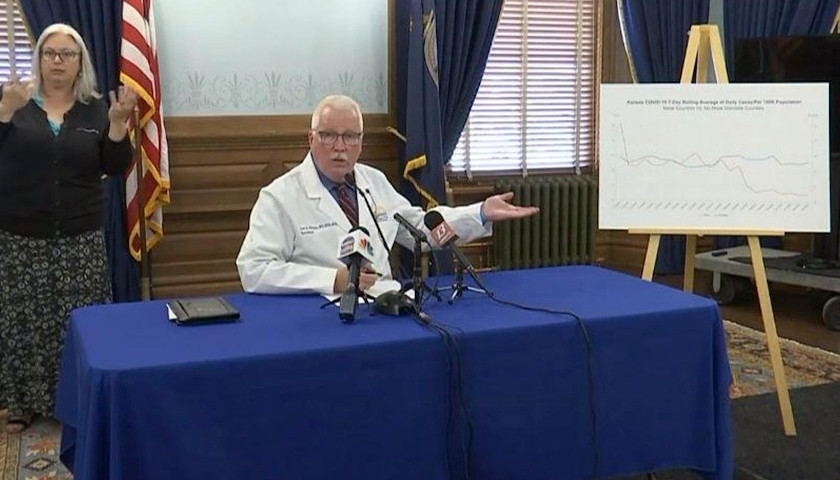by Jon Miltimore
As of early August, 34 US states mandate the use of masks in public to limit the spread of COVID-19.
The efficacy of face masks has been a subject of debate in the health community during the pandemic. Because health experts disagree on their effectiveness, countries and health agencies around the world, including the World Health Organization and the CDC, have done a reversal on their mask recommendations during the pandemic.
Reasonable and persuasive cases can be made both for and against the use of masks in the general population. Unfortunately, the science of masks and viruses is becoming less clear because of the politicized nature of the debate.
A case in point is the Kansas public health official who made news last week after he was accused of using a deceptive chart to make it appear counties with mask mandates had lower COVID-19 case rates than they actually did.
At a press conference, Kansas Department of Health and Environment Secretary Dr. Lee Norman credited face masks with positive statewide COVID-19 trends showing a general decline in deaths, hospitalizations, and new cases.
Norman pointed to a chart (see below) that depicted two lines tracking cases per 100,000 people between July 12 and August 3. The red line begins higher than the blue line but then falls precipitously as it travels down the X-axis, ending below a blue line.
Can you tell from this chart which line — the red or blue — had a higher 7-day rolling average of COVID-19 cases/Per 100k as of Aug. 1?
The red = counties in Kansas with mask mandates.
The blue = counties in Kansas without mask mandates. pic.twitter.com/verLhnni1K
— Jon Miltimore (@miltimore79) August 11, 2020
Norman explains that the red line represented the 15 counties with mask mandates, which account for two thirds of the state’s population. The flat blue line represented the remaining 90 counties, which had no mask mandates in place.
“All of the improvement in case development comes from those counties wearing masks,” Norman said.
The results are clear, Norman claimed. The red line shows reduction. The blue line is flat. Kansas’s real-life experiment showed that masks work.
It didn’t take long for people to realize something wasn’t quite right, however. The blue line and the red line were not on the same axis.
This gave the impression that counties with mask mandates in place had fewer daily cases than counties without mask mandates. This is not the case, however. In reality, counties with masks mandates have far higher daily COVID-19 cases than counties without mask mandates.
If the trends are depicted on the same axis, the blue and red lines look like this.
This is how the blue and red line look on the same axis.
Doesn't make the same impression, does it? pic.twitter.com/1rIHjE2fcY
— Jon Miltimore (@miltimore79) August 11, 2020
Many Kansans were not pleased with the trickery.
Kansas Policy Institute expert Michael Austin told local media that the chart clearly gives a false impression.
“It has nothing to do about whether masks are effective or not. [It’s about] making sure Kansans can make sound conclusions from accurate information,” Austin said. “And unfortunately, the chart that was shown prior in the week strongly suggested that counties that had followed Dr. Norman’s mask order outperformed counties that did not, and that was most certainly not true.”
Twitter was less diplomatic.
https://twitter.com/MiltonWolfMD/status/1292108425133010946?ref_src=twsrc%5Etfw%7Ctwcamp%5Etweetembed%7Ctwterm%5E1292108425133010946%7Ctwgr%5E&ref_url=https%3A%2F%2Ffee.org%2Farticles%2Fthe-sneaky-trick-a-public-health-official-used-to-make-mask-mandates-look-super-effective%2F
HOW TO LIE WITH CHARTS: KANSAS EDITION
this is literal fraud. they just used this chart to support a mask mandate.
but it shows the masked counties on a different axis with a different scale.
they are higher, not lower.
there was no good reason to do this.
it's just lying https://t.co/ikCfTiUBlF
— el gato malo (@boriquagato) August 8, 2020
The chart is deceptive.
Worse, Norman also failed to note that the lines were on different axes until a reporter asked if the blue line “would get below the red line” if those counties passed mask mandates, which prompted Norman to mumble about different metrics and then admit that counties without mask mandates have lower case rates.
“The trend line is what I really want to focus on,” Norman said.
The deception prompted a non-apology from the Kansas Department of Health and Environment: “Yes, the axes are labelled differently … we recognize that it was a complex graph and may not have easily been understood and easily misinterpreted.”
Dr. Norman, meanwhile, vowed to do better next time.
“I’ll learn from that and try to [be] clearer next time,” he said following criticism from lawmakers.
The episode is unfortunate because it further clouds the science and erodes trust in the medical experts individuals rely on to make informed decisions.
It’s also ironic, because the controversy overshadowed the state’s positive data, which suggests masks may be working in Kansas. The chart may have been deceptive, but the data is correct and shows a 34 percent drop in COVID cases in counties with mandates in place.
It’s quite possible that drop is linked to county orders mandating the use of masks. Then again, the order may have nothing to do with the drop. Correlation, we know, doesn’t equal causation. If it did, the surge in COVID-19 cases in California following its mask order would be “proof” that masks increase transmission rates.
But science doesn’t work that way (at least it shouldn’t), and Dr. Norman knows this.
Maybe masks are an effective way to curb transmission of the coronavirus, or maybe it’s largely ineffective or even harmful, like the Surgeon General stated back in March. The truth is we don’t yet know.
What’s clear, as I noted last week, is that the top physicians and public health experts on the planet can’t decide if face coverings help reduce the spread of COVID-19.
In light of this, it seems both reasonable and prudent that public health officials should focus less on forcing people to “mask-up” and more on developing clear and compelling research which will allow individuals to make informed and free decisions.
This, after all, is the traditional role of public health: inform people and let them choose.
Allowing individuals to choose instead of collective bodies is the proper and more effective approach, because, as the great economist Ludwig von Mises reminded us, individuals are the source of all rational decision-making.
“All rational action is in the first place individual action,” Mises wrote in Socialism: An Economic and Sociological Analysis. “Only the individual thinks. Only the individual reasons. Only the individual acts.”
Mask orders aren’t just about public health. They are a microcosm of a larger friction at work in our society: who gets to plan our lives, individuals or the collective?
Despite what many today seem to believe, society is best served by allowing individuals to plan and control their own lives.
But individuals benefit from sound and reliable information. Sadly, that is something public health officials increasingly appear incapable or unwilling to offer.
– – –
Jonathan Miltimore is the Managing Editor of FEE.org. His writing/reporting has been the subject of articles in TIME magazine, The Wall Street Journal, CNN, Forbes, Fox News, and the Star Tribune.






It blows me away how broad and concerted the effort is to push mask wearing. Those of us with two brain cells or more know it’s all BS. What’s the agenda? Why do ‘they’ want us wearing masks? Submission to dictates? Testing the populace for the next step? Who are the sheep?
When are the American people going to wake up to these blatant lies and this gross manipulation? For a variety of reasons, the people who are pushing this death, control, and submission narrative will say anything, do anything, and misrepresent anything to forward it. There is no depth to which they will not stoop, no lie too big, no manipulation too corrupt for their agenda. They are lying to you, changing your lives, ruining your businesses, closing your churches, masking your faces, disrupting the education of your children, destroying a young generation psychologically, and eroding the very foundation of this country and you are willingly complying. Not only are you complying, many of you are also reporting your neighbors when they choose not to fall in line with the deception. Wake up.
Good points in this article. I hope Metro Nashville Health Department and the COVID task force are paying attention. People don’t want to be told what to do, they want information so they can make informed decisions for themselves. Perhaps instead of getting frustrated by people not listening you should address alternate viewpoints and use better persuasion. You can’t come out and say listen to me because I have been doing this for years.
And Mayor Cooper, once you loose credibility it is hard to get it back. You can’t demand people wear masks and socially distance while attending a protest where masks/social distancing were optional. I quit listening to you early on because of your politicalization-where protesting was okay but attending church or funerals was not.